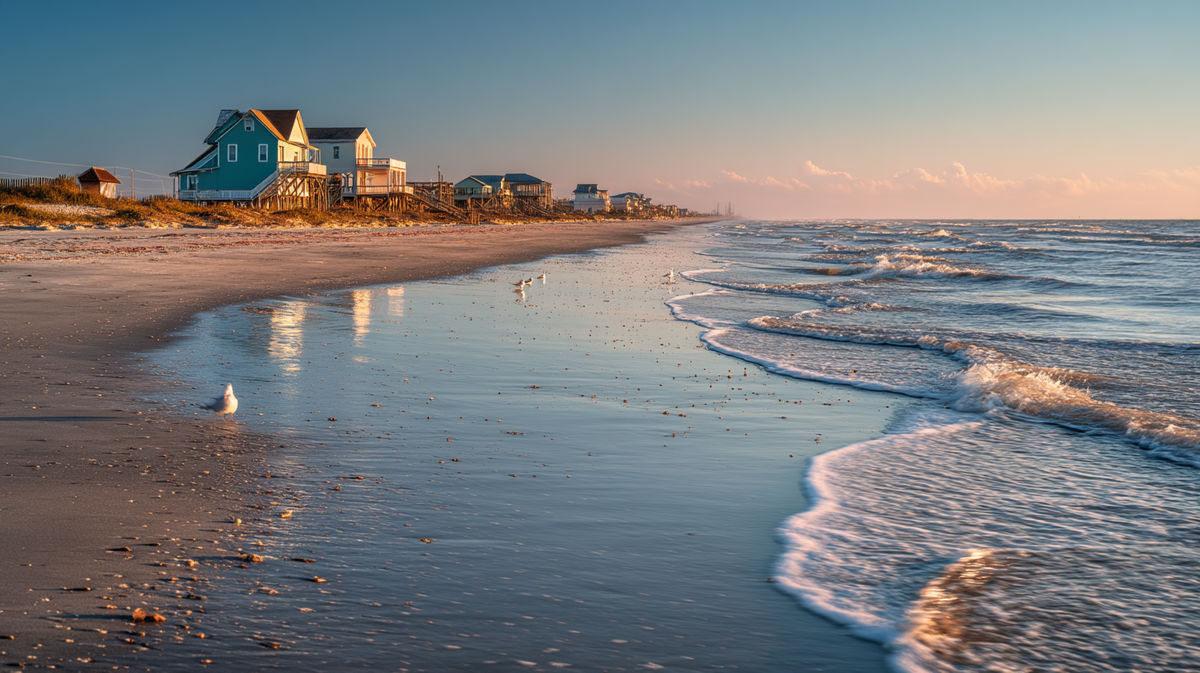Overview of Galveston
Introduction to Living in Galveston, TX
Picture waking up to seabirds, salt air, and a quick stroll to the beach on Galveston Island. That’s everyday life in Galveston, a relaxed coastal city along the Gulf Coast of Texas where bungalows sit beside pastel vacation cottages and shrimp boats bob just offshore.
Folks here surf before work, catch shows at the Grand 1894 Opera House, and fish under the lights of the Galveston Island Historic Pleasure Pier.
But newcomers always ask: “Is the crime rate in Galveston something I should worry about before I hunt for homes for sale in Galveston?”
Geographical Location
The city sprawls across a narrow barrier island, an island city only two miles wide at points, bounded by West Bay to the north and open Gulf water to the south. The busy Seawall slices east to west, connecting hot spots like Stewart Beach, East Beach, and the quieter West End.
Visitors quickly learn that each part of the city feels different: the lively Strand District downtown, the tourist‑heavy East End, and the roomy neighborhoods that consider the southwest part of the island the calmest stretch of sand.
Cost of Living in Galveston
A big perk for anyone moving to Galveston is affordability.
The latest cost‑of‑living index shows everyday expenses run about seven percent lower than the national average—housing, groceries, and utilities included.
Factor in the property‑tax edge Texas offers, and you’ll see why many buyers call it a good place to live, especially when stacking Galveston against cities of the same size around the State of Texas.
Galveston Crime Reports and Data
Property Crime
On balance, property crime drives local headlines. CrimeGrade logs a property‑crime rate per 1,000 residents of 23.33, a slightly higher figure than the state average of 22.24.
Theft tops the chart, followed by burglary and vehicle theft, so locking up bikes and keeping porch lights on is common sense. Your chance of being a victim of a property offense is about 1 in 42, still typical for a Texas tourist hub where short‑term rentals swell visitor numbers.
Violent Crime
Galveston’s violent crime rate sits at 5.082 incidents per 1,000 residents, again above statewide levels but far from “danger zone” status.
Aggravated assault is the most frequent serious offense. The city does record an occasional homicide—“higher murder” stories tend to spike when two or three killings cluster in a single season—but such totals remain low compared with metro giants like Houston or Dallas.
Other Crime
Beyond the usual categories, CrimeGrade tracks “other” offenses—drug‑related, vandalism, identity theft—totaling 8.736 per 1,000 residents.
These numbers help explain why Galveston earns a “D” overall safety grade, yet locals note that many reports stem from heavy tourist traffic downtown rather than the quieter western subdivisions.
Trends in Galveston Crime Rates
Looking five calendar years back, overall crime wobbles rather than surges. The reported crimes dataset shows total incidents drifting between 3 and 5% up or down year‑to‑year, not a runaway spike.
Even so, Galveston still lands on lists of places with one of the highest crime concentrations for beach towns its size, a label driven more by property theft than personal danger.
Crime maps highlight hot spots around the cruise‑ship terminals, while western subdivisions post lower‑than‑average crime.
Comparing Crime Rates: Galveston vs. Nearby Cities
Comparison of Galveston Crime Rates with Texas
When stacked against the entire State of Texas, Galveston runs higher than average for property and violent metrics, yet the gap isn’t huge—roughly one extra incident per thousand residents in each category.
The statewide violent figure (4.592) underscores that Galveston’s challenges are real but not extreme.
Crime Rate Comparison with Nearby Cities
Just across the causeway, Texas City posts a property‑crime rate of 20.97 and violent rate of 4.715 per 1,000 residents—both marginally below Galveston’s numbers.
League City and Friendswood trend even safer, while La Marque and Port Arthur trend worse.
In short, Galveston falls close to regional mid‑pack, despite its reputation.
Identifying the Safest Areas in Galveston
Best Places to Live in Galveston
If you want the safest neighborhoods, study those western addresses.
Crime‑analysis blogs highlight Campeche Cove, Sunny Beach, and West Beach, plus Pirates’ Cove and Lafitte’s Cove as areas in Galveston with lower‑than‑average crime, thanks to gated streets and fewer late‑night bars.
Locals also tout the southwest part of the city around 11‑Mile Road; unsurprisingly, maps shade that part of the city greenest.
Safety Measures and Resources
Chance of Being a Victim of Crime in Galveston
The overall crime rate of 37.15 per 1,000 residents translates to roughly a one‑in‑27 lifetime chance, higher than the national average of about one‑in‑40, but far from the worst on the Texas coast.
Remember, visitor‑heavy blocks can skew ratios because the census counts residents, not tourists.
Role of the Galveston Police Department
The Galveston Police Department staffs community liaisons, a Citizens Police Academy, and National Night Out events focused on keeping residents of Galveston aware of their surroundings and friendly with patrol officers.
Officers also publish online incident dashboards so homeowners can spot trends street by street—handy when you’re deciding where to plant that home in Galveston.
Community Safety Initiatives
Neighborhood watch Facebook groups, school resource officers within the Galveston Independent School District, and university partnerships with Texas A&M‑Galveston all bolster prevention.
Coastal resiliency grants have even financed extra LED lighting around pocket parks, small steps that help brand the Galveston area a place where crime feels manageable rather than menacing.
Living in Galveston: Is it a Safe Place to Live?
So, is Galveston the city to be the safest place to live? Not exactly, but it’s no crime war zone either.
Think of it like any lively island resort: petty theft balloons near nightlife corridors, yet family subdivisions remain calm.
Follow basic safety tips, lock cars, stash beach gear, stay in lit areas at night, and most folks never become a victim of a crime.
Conclusion and Future Outlook
Summary of Crime Statistics
Galveston posts a property‑crime figure of 23.33 and violent‑crime figure of 5.082 per 1,000 residents, numbers sitting a touch above both state and national yardsticks.
Still, isolated pockets, especially the west‑end beach suburbs, score solidly safe grades.
Future Outlook for Crime in Galveston
Tourism will always tug crime stats upward, yet police analytics and civic investment continue to trim year‑over‑year theft totals.
Expanding camera programs downtown and ongoing community patrols suggest incremental improvement rather than worsening TX crime.
Galveston Safety FAQs
How does the crime rate in Galveston compare with the national average?
Galveston logs about 37 crimes per 1,000 residents, roughly ten more incidents than the United States benchmark, so the island sits higher than average nationally but mirrors many coastal tourist hubs.
Are the beaches themselves considered dangerous?
Most shoreline incidents are minor; swimmers simply need to check Texas Beach Watch before heading to Galveston Beach, Stewart Beach, East Beach, or even Galveston Island State Park for temporary bacteria advisories.
Which neighborhoods in Galveston are generally viewed as safest?
Crime‑mapping tools and local chatter point to Campeche Cove, Pirates’ Cove, Sunny Beach, and a few gated pockets on the far West End as the safest neighborhoods thanks to limited through‑traffic and active HOA patrols.
Does Galveston have one of the highest crime rates in Texas?
Among island towns, yes, but statewide lists place Galveston firmly mid‑table; inland towns of similar size can post equal or worse numbers, and certain Houston suburbs actually rank higher for violent offenses.
Are schools in the area considered secure?
Campuses under Galveston Independent School District maintain controlled‑entry systems, dedicated officers, and updated emergency drills, standard safeguards you’ll find in most Texas districts, helping reassure parents evaluating schools in the area before moving to Galveston.




